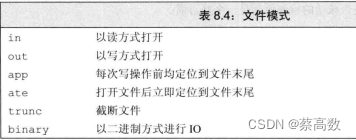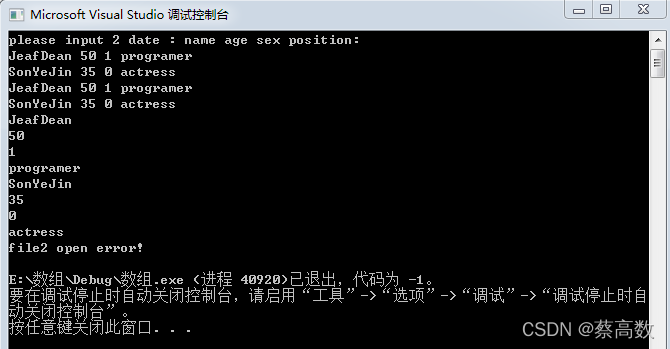您好,登錄后才能下訂單哦!
您好,登錄后才能下訂單哦!
這篇文章主要為大家展示了“C/C++中文件IO函數怎么用”,內容簡而易懂,條理清晰,希望能夠幫助大家解決疑惑,下面讓小編帶領大家一起研究并學習一下“C/C++中文件IO函數怎么用”這篇文章吧。
文件(file)通常是在磁盤或固態硬盤上的一段已命名的存儲區。C中采用的主要是文件指針的辦法,C++中對文件的操作主要運用了“文件流”(即非標準的輸入輸出)的思想。
C把文件看作是一系列連續的字節,每個字節都能被單獨讀取。C提供兩種文件模式:文本模式和二進制模式。
std::FILE* fopen( const char* filename, const char* mode );
打開文件filename并返回與該文件關聯的文件流。mode用于確定文件訪問模式。
| filename | - | 將文件流關聯到的文件名 |
| mode | - | 以空字符結尾的字符串確定文件訪問模式 |
如果成功,則返回一個指向控制已打開文件流的對象的指針,同時清除 eof 和錯誤位。出錯時,返回一個空指針。

int fclose(FILE *stream)
C 庫函數 int fclose(FILE *stream) 關閉流 stream。刷新所有的緩沖區。
參數
stream 是指向 FILE 對象的指針,該 FILE 對象指定了要被關閉的流。
返回值
如果流成功關閉,則該方法返回零。如果失敗,則返回 EOF。
C語言的stdio.h頭文件中定義了用于文件操作的結構體FILE。通過fopen返回一個文件指針(指向FILE結構體的指針)來進行文件操作。可以在stdio.h頭文件中查看FILE結構體的定義,如下:

不過在visual studio中貌似被隱藏了,見https://docs.microsoft.com/en-us/cpp/porting/visual-cpp-change-history-2003-2015
文件I/O函數 fprintf() 和 fscanf() 函數的工作方式與 printf() 和 scanf()類 似,區別在于前者需要用第1個參數指定待處理的文件。
int fprintf(FILE *stream, const char *format, ... ); fprintf()函數根據指定的format(格式)發送信息(參數)到由stream(流)指定的文件. int fscanf(FILE *stream, const char *format, ...) C庫函數 int fscanf(FILE *stream, const char *format, ...) 從流stream讀取格式化輸入。
stream -- 指向 FILE 對象的指針,該 FILE 對象標識了流。
format -- C 字符串,包含了以下各項中的一個或多個:空格字符、非空格字符 和 format 說明符。
成功則返回成功賦值或寫入的個數,失敗或到達文件末尾返回負數。
頭文件fstream 定義了三個類型來支持文件IO: ifstream從一個給定文件讀取數據,ofstream向一個給定文件寫入數據,以及fstream可以讀寫給定文件。

每個流都有一個關聯的文件模式(file mode),用來指出如何使用文件。表8.4列出了文件模式和它們的含義。

每個文件流類型都定義了一個默認的文件模式,當未指定文件模式時就使用此默認模式。與ifstream關聯的文件默認以in模式打開,與ofstream關聯的文件默認以out模式打開,與fstream關聯的文件默認以in和out模式打開。
默認情況下,打開一個ofstream時,文件的內容會被丟棄。阻止一個ofstream清空給定文件內容的方法是同時指定app或in模式:
//在這幾條語句中,filel都被截斷
ofstream out ("filel"); //隱含以輸出模式打開文件并截斷文件
ofstream out2("file1", ofstream::out); //隱含地截斷文件
ofstream out3("file1", ofstream::out | ofstream::trunc);
//為了保留文件內容,顯式指定app模式
ofstream app("file2", ofstream::app); //隱含為輸出模式
ofstream app2("fi1e2", ofstream::out | ofstream::app);#include<iostream>
#include<string>
#include<algorithm>
#include<sstream>
#include<fstream>
#include<stdio.h>
using namespace std;
const int MAX_NUM = 100;
int a[MAX_NUM];
int n = 2;
int main(int argc, char* argv[])
{
FILE* file4 = fopen("d.txt", "w");
if (!file4) {
printf("file4 open error!\n");
return -1;
}
//fprintf(file4, "name age sex position\n");
int age, sex;
char name[50], position[50];
printf("please input 2 date : name age sex position:\n");
while (n--)
{
scanf("%s %d %d %s", &name, &age, &sex, &position);
fprintf(file4, "%s %d %d %s\n", name, age, sex, position);
}
fclose(file4);
FILE* file5 = fopen("d.txt", "r");
if (!file5) {
printf("file5 open error!");
return -1;
}
int m = 2, ans, ans1;
while (m--)
{
fscanf(file5, "%s %d %d %s", &name, &age, &sex, &position);
printf("%s %d %d %s\n", name, age, sex, position);
}
fclose(file5);
fstream file1("d.txt");
if (!file1) {
cout << "file1 open error! " << endl;
return -1;
}
string tmp;
vector<string>str;
while (file1 >> tmp)
{
str.push_back(tmp);
cout << tmp << endl;
}
ifstream file2("b.txt", ios::in);
if (!file2) {
cout << "file2 open error! " << endl;
return -1;
}
ofstream file3("c.txt", ios::out);
if (!file3) {
cout << "file3 open error! " << endl;
return -1;
}
while (n--)
{
file3 << n<<' ';
}
file1.close();
file2.close();
file3.close();
return 0;
}輸入輸出結果如下:

以上是“C/C++中文件IO函數怎么用”這篇文章的所有內容,感謝各位的閱讀!相信大家都有了一定的了解,希望分享的內容對大家有所幫助,如果還想學習更多知識,歡迎關注億速云行業資訊頻道!
免責聲明:本站發布的內容(圖片、視頻和文字)以原創、轉載和分享為主,文章觀點不代表本網站立場,如果涉及侵權請聯系站長郵箱:is@yisu.com進行舉報,并提供相關證據,一經查實,將立刻刪除涉嫌侵權內容。